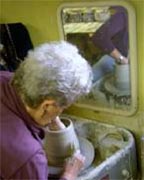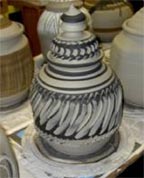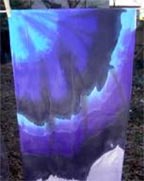


Click here for a gallery of Marjory’s urns and shawls
Marjory has been a member of Seekers church for over 30 years. Below, she makes a brief statement about her lifelong love of pottery which has been a spiritual practice for her.
“I learned to throw, trim, glaze and fire porcelain with Louie Mideke in Bellingham, Washington, the year that my husband was in Vietnam (1965). Death was much on my mind then, but making pots always included firing the clay to make the pieces more permanent. When we moved to Washington, D.C. in 1970, I became a full-time potter. I was part of the group that scrubbed and painted the old Torpedo Factory in Alexandria, making it a center where artists could work and sell directly. For ten years, I worked as a professional potter.
Then, in 1980, we moved to Germany where I had no studio and no market for my pots. I began writing and when my husband retired from the Army, I went to seminary and left pottery for good (I thought). In 1987, a friend of ours died in a car crash and his brother asked me to make a vessel for his ashes. There wasn’t time to make a pot and fire it, and besides, his family wanted to scatter his ashes in Chesapeake Bay by his crab pots, so they really wanted something that would disintegrate with the ashes. So I made my first unfired urn and discovered that the container was just what they needed!
The next opportunity came in 1995, when I worked with the children of our church community to make a vessel for ashes of a newborn that the family had been carrying for ten years, waiting for the right community and the right place to deposit them. Creating the raw clay vessel for those ashes was a sacred journey for all of us. In the years since then, I have made unfired urns for special friends…to transport ashes from the crematorium to the place where they will be scattered. They are not meant to be permanent or protective over time. Instead, they are meant to accompany the deceased.
The painted silk shawls allowed me to add color and texture in contrast to the plain grey pots. In both Jewish and Christian traditions, a prayer shawl is used to set apart sacred time and space. To conduct a burial service, one would normally wear such a stole. It seems like an appropriate accompaniment for the urns and a special garment to wear and pray with after the urn has been released. “